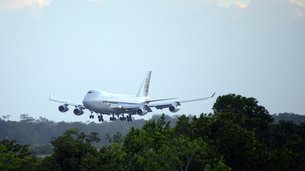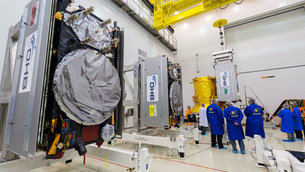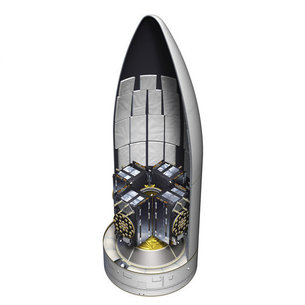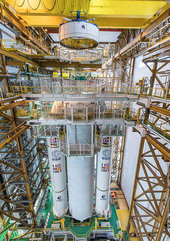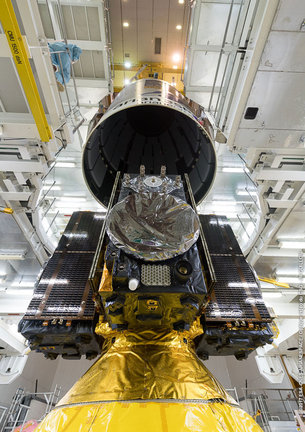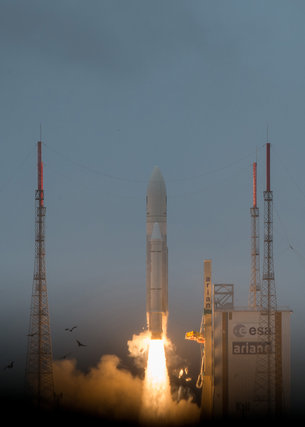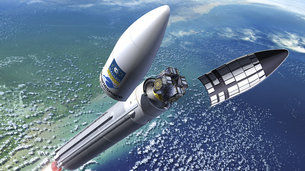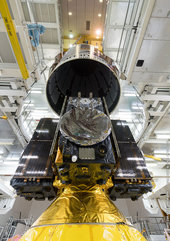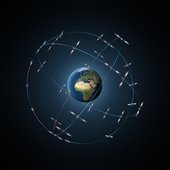15.09.2017
The Ariane 5 for Arianespace’s next Galileo mission arrives at the Spaceport

The cryogenic main stage for Arianespace’s Flight VA240 is transported across the Spaceport after arriving in French Guiana aboard the MN Colibri roll-on/roll-off ship.
Elements for Arianespace’s Ariane 5 mission in December have been delivered to the Spaceport in French Guiana for the heavy-lift launcher’s second flight at the service of Europe’s Galileo global satellite navigation system.
These components arrived this month in French Guiana aboard the MN Colibri, which is one of two sea-going roll-on/roll-off ships that transport launcher hardware from Europe to the South American launch site for Arianespace’s family of launch vehicles.
The year-end launch will orbit four more Galileo spacecraft, to be deployed into medium Earth orbit from a dispenser system on the Ariane 5 ES launcher version equipped with a re-ignitable upper stage. Galileo is designed to provide a new European global satellite navigation system with precision positioning services under civilian control.
A December liftoff for Ariane 5 and its Galileo satellites
Designated Flight VA240 in Arianespace’s launcher family numbering system, the mission is targeted for December 12. As the latest mission carrying Galileo satellites, Flight VA240 is to be performed on behalf of the European Commission under a contract with the European Space Agency (ESA).

The two half-shells for Ariane 5’s payload fairing enter the Spaceport aboard separate flatbed trucks. When assembled on Ariane 5, the fairing will protect Flight VA240’s Galileo satellites during the launcher’s ascent through the atmosphere’s denser layers.
-
Galileo is funded by the European Union, with overall responsibility for management and implementation held by the European Commission. ESA is assigned design and development of the new generation of systems and infrastructure.
Arianespace already has launched 18 Galileo spacecraft, with four being orbited on a previous Ariane 5 mission (Flight VA233 in November 2016), and the others lofted by seven medium-lift Soyuz vehicles carrying two satellites each.
Quelle: arianespace
---
Update: 3.10.2017
.
Ankunft von Galileo Satelliten 19+20 bei Spaceport in French Guiana


GALILEO PAIR ARRIVES IN FRENCH GUIANA
Europe’s next two Galileo navigation satellites have touched down in Europe’s Spaceport in French Guiana ahead of the launch of a quartet by Ariane 5 at the end of this year.
Galileos 19 and 20 left Luxembourg Airport on a Boeing 747 cargo jet on the morning of 18 September, arriving at Cayenne – Félix Eboué Airport in French Guiana that evening.
Safely cocooned within protective air-conditioned containers, the pair were offloaded and driven to the cleanroom environment of the preparation building within the space centre.
This building will remain their home as preparations for their launch proceeds, with the next two Galileos due to join them later this month.
The satellites join the first elements of their customised Ariane 5 at the centre – including its cryogenic main stage and half-shell payload fairing – which were delivered by ship the week before.
Galileo is Europe’s own satellite navigation system, providing an array of positioning, navigation and timing services to Europe and the world.
A further eight Galileo ‘Batch 3’ satellites were ordered last June, to supplement the 26 built so far.
Quelle: ESA
---
Update: 24.10.2017
.

GALILEO IN PLACE FOR LAUNCH: THEN THERE WERE FOUR
Two more Galileo satellites have reached Europe’s Spaceport in French Guiana, joining the first pair of navigation satellites and the Ariane 5 rocket due to haul the quartet to orbit this December.
Galileos 21 and 22 left Luxembourg Airport on a Boeing 747 cargo jet on the morning of 17 October, arriving at Cayenne – Félix Eboué Airport in French Guiana on the same day.
Resting within distinctive white air-conditioned containers, the satellites were driven to the cleanroom environment of the preparation building within the space centre.
Waiting for them there were Galileos 19 and 20, which arrived in September.

Inside aircraft
-
The four satellites will be launched together in mid-December by a customised Ariane 5, the elements of which reached French Guiana last month by sea.
Galileo is Europe’s own satellite navigation system, providing an array of positioning, navigation and timing services to Europe and the world.
A further eight Galileo ‘Batch 3’ satellites were ordered last June, to supplement the 26 built so far.

With 18 satellites now in orbit, Galileo began initial services on 15 December 2016, the first step towards full operations.
Further launches will continue to build the constellation, which will gradually improve performance and availability worldwide.
Quelle: ESA
---
Update: 5.11.2017
.
Four Galileo spacecraft are prepared for their December Ariane 5 launch
Payload processing for Arianespace’s second Ariane 5 mission in support of Europe’s Galileo global navigation system has reached full speed, with all four satellites now at the Spaceport.

One of the latest-delivered Galileo satellites is removed from its protective shipping container inside the Spaceport’s S1A payload preparation facility.
Liftoff of Arianespace’s Ariane 5 with these satellites is targeted for December 12, coming after the heavy-lift workhorse’s previous flight at the service of Galileo, which successfully delivered four other spacecraft to medium-Earth circular orbit in November 2016.
The upcoming mission is designated Flight VA240 in Arianespace’s launcher family numbering system, denoting the 240th performed with an Ariane-series vehicle from the Spaceport. It also will be the company’s 11th and final launch in 2017, closing out a busy year of space lift activity.
A global navigation system for Europe
As the latest mission carrying Galileo satellites, Flight VA240 is to be conducted on behalf of the European Commission under a contract with the European Space Agency (ESA). Galileo is funded by the European Union, with overall responsibility for management and implementation held by the European Commission. ESA is assigned design and development of the new generation of systems and infrastructure.
Arianespace already has launched a total of 18 Galileo spacecraft, including the four orbited by Ariane 5 in November 2016, plus the others lofted by seven preceding medium-lift Soyuz vehicles that carried two satellites each.
Quelle: arianespace
---
Update: 17.11.2017
.
Ariane 5 and its Galileo satellites are prepared for Arianespace’s December 12 mission



Inside the Spaceport’s Launcher Integration Building, Ariane 5’s vehicle equipment bay is lowered atop the core cryogenic stage on Flight VA240’s Ariane 5 ES launcher version (left and center photos). This cleared the way for installation of the launch vehicle’s EPS storable propellant upper stage (at right).
The Ariane 5 for Arianespace’s December 12 year-ending flight for 2017 has completed its initial build-up at the Spaceport in French Guiana – where preparations also are moving ahead with four satellite passengers that will further expand Europe’s Galileo global navigation system once in their final orbit.
During activity in the Spaceport’s Launcher Integration Building, this heavy-lift vehicle for Arianespace Flight VA240 underwent the assembly process that began by mating its two solid propellant strap-on boosters with the main cryogenic stage.
The next step was integration of Ariane 5’s vehicle equipment bay, which serves as the launch vehicle’s “brain,” providing autonomous control during the various mission phases.
The Ariane 5 ES difference
It was followed by installation of the EPS storable propellant stage, powered by a re-ignitable engine that operates with MMH and N2O4 propellants. This differentiates the Ariane 5 ES configuration from Arianespace’s Ariane 5 ECA version – which has a cryogenic upper stage and typically is used on Arianespace missions with telecommunications satellites to geostationary transfer orbits.
After completion of verifications and systems checkout by production prime contractor ArianeGroup, the Ariane 5 ES launch vehicle will be moved to the Spaceport’s Final Assembly Building for payload integration and readiness for rollout to the launch zone.
The mission’s ongoing payload preparations – which so far included the checkout and fit-check procedure for each of the four Galileo satellites – took place inside the Spaceport’s S1A processing facility. This involved a one-by-one verification of the spacecraft’s interface with the payload dispenser that will release them into circular orbit during the mission.
Galileo satellites checked…and fit
After the fit-check procedure in the S1A facility, the four satellites were readied for transfer to the S3B payload preparation center for fueling.
For Ariane 5’s December 12 mission, the heavy-lift vehicle will carry its quartet of Galileo satellites (weighing approximately 715 kg. each) and their dispenser system for a medium-Earth orbit deployment.
Galileo is the European initiative to develop a global satellite navigation system. Under civilian control, it will offer a guaranteed, high-precision positioning service. As a European Union-funded program, the Galileo constellation will comprise 24 operational satellites, along with spares.
Overall responsibility for Galileo’s management and implementation is held by the European Commission, with the European Space Agency assigned design and development of the new generation of systems and infrastructure.
Ariane 5’s mission with the four Galileo spacecraft will close out a busy year of launch activity for Arianespace, which has performed 10 missions from French Guiana so far in 2017 – all of which were successful. The flights to date involved five launches of the heavy-lift Ariane 5, two with the medium Soyuz and three with the lightweight Vega.

In the Spaceport’s S1A clean room facility, three of the four Galileo satellites for Flight VA240 are prepared for their fit-check with the mission’s payload dispenser (left). At right, one of the spacecraft undergoes the fit-check process.

Quelle: arianespace
---
Update: 22.11.2017
,
GALILEO QUARTET FUELLED AND READY TO FLY
Europe’s next four Galileo navigation satellites and the Ariane 5 rocket due to lift them into orbit are being readied for their 12 December launch from Europe’s Spaceport in Kourou, French Guiana.
Tuesday saw Galileo satellites 19–22 declared ready for flight, along with their Ariane. Combined activities are now under way, culminating in the satellites meeting their rocket in the Final Assembly Building.
The satellites were flown in pairs to French Guiana last month. Once safely unboxed in the Spaceport’s cleanroom environment, they were tested to ensure they had suffered no damage during their transatlantic flights.
Next came their ‘fit check’, when they were mechanically and electrically linked one by one to the dispenser that will carry them during their ascent to the target 23 500 km-altitude orbit, before releasing them into space.
Last Friday saw the satellites filled with enough fuel to fine-tune their orbits and orientation during their projected 12 year working lives. Next, they will be attached to their dispenser together for the final time.
In parallel, their customised Ariane 5 is being assembled. Two solid-propellant boosters were mated with its main cryogenic stage before the addition of the interstage that carries the electronics to control the vehicle.
Next came the addition of the storable propellant stage, powered by a reignitable engine, which will deliver the quartet to their target orbit.
Once fully checked, the Ariane will be moved to the final building for the addition of the satellites atop their dispenser, sealed within their protective fairing.
This launch will bring the total Galileo constellation to 22, boosting the global availability of navigation signals. Galileo began Initial Services just under a year ago, the first step before full operations, on 15 December.
Flight VA240: Arianespace’s second Ariane 5 launch for the Galileo constellation and Europe

For its 11th launch of the year, and the sixth Ariane 5 liftoff from the Guiana Space Center (CSG) in French Guiana during 2017, Arianespace will orbit four more satellites for the Galileo constellation.
This mission is being performed on behalf of the European Commission under a contract with the European Space Agency (ESA).
For the second time, an Ariane 5 ES version will be used to orbit satellites in Europe’s own satellite navigation system. At the completion of this flight, designated Flight VA240 in Arianespace’s launcher family numbering system, 22 Galileo spacecraft will have been launched by Arianespace with Soyuz and Ariane 5 launchers.
A final Ariane 5 ES mission will deploy four additional Galileo constellation satellites in 2018, after which Ariane 6 takes over from 2020-2021 – with its initial two Galileo launches contracted by ESA on behalf of the European Commission in September 2017.
The Flight VA240 will be from Ariane Launch Complex No. 3 (ELA 3) in Kourou, French Guiana.
The Launch Readiness Review (LRR) will take place on Friday, December 8, 2017 in Kourou, to authorize the start of operations for the final countdown.
Galileo is Europe’s own global navigation satellite system. Under civilian control, Galileo offers guaranteed high-precision positioning around the world. Its initial services began in December 2016, allowing users equipped with Galileo-enabled devices to combine Galileo and GPS data for better positioning accuracy.
The complete Galileo constellation will comprise a total of 24 operational satellites (along with spares); 18 of these satellites already have been orbited by Arianespace.
ESA transferred formal responsibility for oversight of Galileo in-orbit operations to the GSA (European GNSS Agency) in July 2017.
Therefore, as of this launch, the GSA will be in charge of the operation of the Galileo satellite navigation systems on behalf of the European Union. GSA will be responsible for operating these satellites as soon as they separate from the launcher. Satellite positioning operations and system operation will be carried out in conjunction with ESA.

For its 11th launch of the year, and the sixth Ariane 5 liftoff from the Guiana Space Center (CSG) in French Guiana during 2017, Arianespace will orbit four more satellites for the Galileo constellation.
This mission is being performed on behalf of the European Commission under a contract with the European Space Agency (ESA).
For the second time, an Ariane 5 ES version will be used to orbit satellites in Europe’s own satellite navigation system. At the completion of this flight, designated Flight VA240 in Arianespace’s launcher family numbering system, 22 Galileo spacecraft will have been launched by Arianespace.
Arianespace is proud to deploy its entire family of launch vehicles to address Europe’s needs and guarantee its independent access to space.

Quelle: arianespace
---
Update: 9.12.2017
.
GALILEO SATELLITES ATOP ROCKET FOR NEXT TUESDAY’S FLIGHT
Europe’s next four Galileo navigation satellites are in place atop their Ariane 5, ready to be launched next Tuesday.
Liftoff from Europe’s Spaceport in Kourou, French Guiana is scheduled for 18:36 GMT (19:36 CET, 15:36 local time), carrying Galileo satellites 19–22.
Completion of Galileo’s Ariane 5 rocket took place in the Spaceport’s Final Assembly Building, following the arrival there of the quartet of satellites, already attached to the dispenser that will hold them in position during launch, then release them into their target 22 922 km-altitude orbit
Next, the satellites plus dispenser were placed atop the Ariane 5’s upper stage, after which the 14 m-long protective fairing was lowered over the Galileos – the last time they will be seen by human eyes. This fairing will protect them from the onrushing atmosphere during ascent.
Liftoff from Europe’s Spaceport in Kourou, French Guiana is scheduled for 18:36 GMT (19:36 CET, 15:36 local time), carrying Galileo satellites 19–22.
Completion of Galileo’s Ariane 5 rocket took place in the Spaceport’s Final Assembly Building, following the arrival there of the quartet of satellites, already attached to the dispenser that will hold them in position during launch, then release them into their target 22 922 km-altitude orbit
Next, the satellites plus dispenser were placed atop the Ariane 5’s upper stage, after which the 14 m-long protective fairing was lowered over the Galileos – the last time they will be seen by human eyes. This fairing will protect them from the onrushing atmosphere during ascent.


The next step will be Monday’s rollout to the launch zone.
This mission will bring the Galileo system to 22 satellites. Initial Services began almost a year ago, on 15 December 2016.
Next year’s launch of another quartet will bring the constellation of 24 satellites to completion, plus two orbital spares.
Galileo is Europe’s civil global satellite navigation system. It will allow users worldwide to know their exact position in time and space with great precision and reliability.
Quelle: ESA
---
Update: 11.12.2017
.
WATCH THE LAUNCH OF GALILEOS 19–22

Europe’s Galileo satellite navigation system will come a giant leap nearer completion on Tuesday 12 December, as four more Galileo satellites are launched into orbit by Ariane 5.
Liftoff from Europe’s Spaceport in Kourou, French Guiana is scheduled for 18:36 UTC (19:36 CET, 15:36 local time), carrying Galileo satellites 19–22. Separation of the upper stage will occur about nine minutes after liftoff, followed by the first firing of the upper stage.
The upper stage – carrying four 715-kg Galileo satellites – will fly in ballistic configuration for three hours and eight minutes, after which a second upper stage firing will place it into circular separation orbit.
Once stabilised at 3h 35 min after liftoff, the Galileo dispenser will release the first two satellites, followed by the second pair 20 minutes later.
At orbital injection the launcher will have attained an altitude of 22 925 km, approximately 300 km below the Galileo satellites’ operational altitude. The four satellites will manoeuvre themselves up to this height, leaving the passivated upper stage safely in a ‘graveyard orbit’.
The first Livestream transmission is scheduled for 18:10 GMT (19:10 CET), covering the liftoff, ascent and first phases of flight.
A follow-up Livestream transmission will take place at 22:00 GMT (23:00 CET), to cover the satellite separations and confirmation of success.
Quelle: ESA
---
Update: 12.12.2017
.
Ariane 5 moves to the launch zone for Arianespace’s mission with four Galileo satellites

Arianespace’s Ariane 5 for Flight VA240 nears the completion of its rollout to the Spaceport’s ELA-3 launch zone for tomorrow’s afternoon liftoff with four Galileo satellites.
The next four spacecraft to join Europe’s Galileo satellite navigation system are one step closer to launch following the rollout of their Ariane 5 at the Spaceport in French Guiana.
With today’s transfer from the Spaceport’s Final Assembly Building to the ELA-3 launch zone, Arianespace’s year-ending mission of 2017 can now enter its final countdown for liftoff tomorrow afternoon.
Designated Flight VA240 in Arianespace’s launcher family numbering system, the December 12 launch will deploy its Galileo spacecraft cluster into medium Earth orbit (MEO) at the completion of a mission lasting 3 hours, 55 minutes.
During the trajectory, Ariane 5’s storable propellant upper stage will perform two burns, which are to be separated by a 3-hour, 8-minute ballistic phase.
The satellites have a liftoff mass of approximately 715 kg. each, with Ariane 5’s overall payload lift performance on Flight VA240 set at 3,282 kg.
Liftoff time for Flight VA240:
| French Guiana | Washington, D.C. | Universal Time (UTC) | Paris |
| At 3:36:07 p.m. on December 12 |
At 1:36:07 p.m. on December 12 |
At 18:36:07 on December 12 |
At 7:36:07 p.m. on December 12 |
Quelle: arianespace
+++


+++
18.45 MEZ:

+++19.20 MEZ




+++













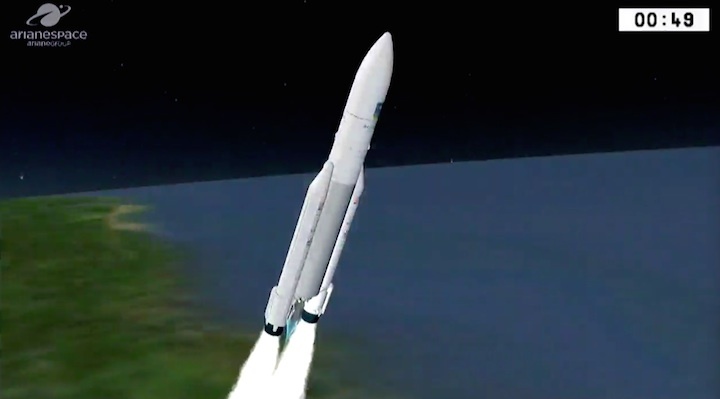



+++











+++
---
Update: 13.12.2017
.
Erfolgreicher Start von ArianeV-VA-240 mit vier Galileo-Satelliten

GALILEO LAUNCH BRINGS NAVIGATION NETWORK CLOSE TO COMPLETION
Europe has four more Galileo navigation satellites in the sky following their launch on an Ariane 5 rocket. After today’s success, only one more launch remains before the Galileo constellation is complete and delivering global coverage.
Ariane 5, operated by Arianespace under contract to ESA, lifted off from Europe’s Spaceport in Kourou, French Guiana at 18:36 GMT (19:36 CET, 15:36 local time), carrying Galileo satellites 19–22. The first pair of 715 kg satellites was released almost 3 hours 36 minutes after liftoff, while the second pair separated 20 minutes later.
They were released into their target 22 922 km-altitude orbit by the dispenser atop the Ariane 5 upper stage. In the coming days, this quartet will be steered into their final working orbits. There, they will begin around six months of tests – performed by the European Global Navigation Satellite System Agency (GSA) – to check they are ready to join the working Galileo constellation.
This mission brings the Galileo system to 22 satellites. Initial Services began almost a year ago, on 15 December 2016.
“Today’s launch is another great achievement, taking us within one step of completing the constellation,” remarked Jan Wörner, ESA’s Director General.
“It is a great achievement of our industrial partners OHB (DE) and SSTL (GB) for the satellites, as well as Thales-Alenia-Space (FR, IT) and Airbus Defense and Space (GB, FR) for the ground segment and all their subcontractors throughout Europe, that Europe now has a formidable global satellite navigation system with remarkable performance.”
Paul Verhoef, ESA’s Director of Navigation, added: “ESA is the design agent, system engineer and procurement agent of Galileo on behalf of the European Commission. Galileo is now an operating reality, so, in July, operational oversight of the system was passed to the GSA.
“Accordingly, GSA took control of these satellites as soon as they separated from their launcher, with ESA maintaining an advisory role. This productive partnership will continue with the next Galileo launch, by Ariane 5 in mid-2018.
“Meanwhile, ESA is also working with the European Commission and GSA on dedicated research and development efforts and system design to begin the procurement of the Galileo Second Generation, along with other future navigation technologies.”
Next year’s launch of another quartet will bring the 24‑satellite Galileo constellation to the point of completion, plus two orbital spares.
About Galileo
Galileo is Europe’s civil global satellite navigation system. It will allow users worldwide to know their exact position in time and space with great precision and reliability. Once complete, the system will consist of 24 operational satellites and the ground infrastructure for the provision of positioning, navigation and timing services.
The Galileo programme is funded and owned by the EU. The European Commission has the overall responsibility for the programme, managing and overseeing the implementation of all programme activities.
Galileo’s deployment, the design and development of the new generation of systems and the technical development of infrastructure are entrusted to ESA. The definition, development and in-orbit validation phases were carried out by ESA, and co‑funded by ESA and the European Commission.
GSA is ensuring the uptake and security of Galileo. Galileo operations and provision of services were entrusted to the GSA in July 2017.
Learn more about Galileo at:
http://www.esa.int/Our_Activities/Navigation
About the European Space Agency
The European Space Agency (ESA) provides Europe’s gateway to space.
ESA is an intergovernmental organisation, created in 1975, with the mission to shape the development of Europe’s space capability and ensure that investment in space delivers benefits to the citizens of Europe and the world.
ESA has 22 Member States: Austria, Belgium, the Czech Republic, Denmark, Estonia, Finland, France, Germany, Greece, Hungary, Ireland, Italy, Luxembourg, the Netherlands, Norway, Poland, Portugal, Romania, Spain, Sweden, Switzerland and the United Kingdom. Slovenia is an Associate Member.
ESA has established formal cooperation with six Member States of the EU. Canada takes part in some ESA programmes under a Cooperation Agreement.
By coordinating the financial and intellectual resources of its members, ESA can undertake programmes and activities far beyond the scope of any single European country. It is working in particular with the EU on implementing the Galileo and Copernicus programmes as well as with Eumetsat for the development of meteorological missions.
ESA develops the launchers, spacecraft and ground facilities needed to keep Europe at the forefront of global space activities.
Today, it develops and launches satellites for Earth observation, navigation, telecommunications and astronomy, sends probes to the far reaches of the Solar System and cooperates in the human exploration of space. ESA also has a strong applications programme developing services in Earth observation, navigation and telecommunications.
Quelle: ESA

